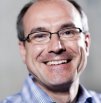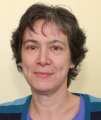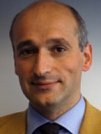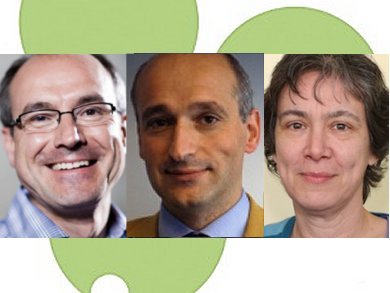CatchBio is a consortium of 21 partners from industry and academia, partly financed by the Dutch ministeries of Economic Affairs and of Education, Culture and Science, and with the support office based at the Netherlands Organization for Scientific Research (NWO). It is an ambitious research program of eight years in the field of catalytic biomass conversion covering the whole spectrum of biofeed into fuels, chemicals, and pharmaceuticals in an integrated manner.
Vera Koester from ChemViews Magazine talks with Bert Weckhuysen, scientific director of CatchBio and Professor of Inorganic Chemistry and Catalysis, Utrecht University, the Netherlands, Elisabeth Bouwman, project leader and Professor of Inorganic Chemistry, Leiden University, the Netherlands, and Ed de Jong, Avantium Chemicals B, Amsterdam, the Netherlands, about their experiences with CatchBio, what they expect from the project, and why it is so unique.
Why do you think CatchBio was created in the Netherlands?
Bert Weckhuysen: The Netherlands has a rich tradition where chemical industries and catalyst producing companies are in tight contact with academia – and this goes back to 1991 when we formally established what we call NIOK, the Netherlands Institute for Research in Catalysis. Since then the very good relationships between catalysis groups in the Netherlands have been formalized with also active participation with our chemical industry. This has led to several big, joint research programs. The most recent one is CatchBio. Here we join forces to work on catalytic biomass conversion and the creation of energy carriers, chemicals and pharmaceutical intermediates based on biomass.
We have in NIOK what we call an Industrial Advisory Board, where we discuss ideas like how we can strengthen the catalysis research infrastructure in the Netherlands. This is, to my best knowledge, rather unique in Europe and has inspired other countries, for example, the USA and Germany where these kinds of networks are now also being set up.
And why biomass conversion?
Bert Weckhuysen: That is, firstly, because we felt that that was a new challenge and, secondly, because in the Netherlands we are both a densely populated and a very agriculturally rich country. So we extended NIOK to other partners that were already active in biomass valorization. That included Wageningen University, which is well known for its agricultural activities, and the other one was the Energy Research Center of The Netherlands, ECN.
What got you interested in CatchBio, Professor Bouwman?
Elisabeth Bouwman: It is interesting and also challenging to think along new lines. For example, for many of the chemicals that are made nowadays, their processes were established in the 1940s or so. They are all based on the same kind of thinking. You take this substrate and you do this reaction and you get that molecule.
The interesting and challenging thing about CatchBio is that you have to start from new molecules. To take something that already exists and comes from biomass, and then you have to think of a totally new way of making existing molecules from these substrates.
How has the field of catalytic conversion of biomass changed over the last decade?
Bert Weckhuysen: It changed from more general research towards more fundamental and understanding-based approaches. Understanding the processes becomes more interesting than just being able to do something. Very generally speaking: Whereas in the beginning it was much more a case of, we take a pot, we throw the biomass in and see what happens, now the stability of the catalyst materials, the physical processes taking place, etc. are studied.
And how does your research fit into this topic?
Bert Weckhuysen: We use spectroscopy to characterize what is going on during a reaction and to detect intermediates to understand what the reaction pathway is. By understanding the reaction pathway you can intervene in that process.
We also work on lignin, and we are also studying the deactivation processes. For example, one of the deactivation products in sugar chemistry is humin. You can find humins in soil. They are organic polymers with an undefined structure. Also lignin has an undefined structure. That brings me to the analytical challenge. The catalytic biomass conversion issues are also part of the analytical challenge. What do you have in your hands? Then, what are proper model compounds to start testing catalytic materials? If you have model compounds you can give the research a much more scientific spin, and move it away from putting some unknown thing into a vessel, adding a catalyst, shaking it for a while and analyzing what it gives. This is where the field is heading, as I mentioned already, and — that is not easy.
What is your research focused on Professor Bouwman?
Elisabeth Bouwman: I am an inorganic chemist. I started my work as a coordination chemist making transition metal complexes. I study their properties and try to apply them to different things such as catalysis, but also advanced materials, for instance, in lighting. Now I am more and more focusing on the use of these complexes in catalysis.
What is most fascinating for you about this?
Elisabeth Bouwman: The most fascinating thing is that the knowledge of transition metal compounds in general is never complete. So many different coordination compounds are known, so if you find a slightly different new one, it may have completely different properties. Also in catalysis often a catalyst that is known to be active in a certain reaction, it may occur that, when you slightly change the ligand or the reaction conditions, you can find totally new reactivity.
To give an example from my recent research: We were trying to do a known reaction that had been reported in literature twenty years ago. With milder reaction conditions and slightly different ligands, we found totally different results. This is very challenging, but it also is very fascinating.
How do you make decisions on which projects to go with?
Bert Weckhuysen: We have a Scientific Advisory Board which ranks projects scientifically. And then we have an industrial ticketing system. Each company receives a number of so-called tickets according to the money they gave to the CatchBio program. Projects with the most tickets and which are scientifically rated well, will go on.
So this gives the industry quite an exposed role.
Bert Weckhuysen: Yeah, which is unusual for academic research. We have to make our academic researcher a bit familiar with this. Normally researchers are interested in publishing a nice paper in, let’s say, Angewandte and then if it gains enough interest, the research is successful.
Elisabeth Bouwman: It is a good thing that there are so many industrial stakeholders present at the CatchBio progress meetings. They see the problems that we, as researchers, go through and they can also say when something starts to be commercially attractive and ready to be implemented by industry. So it’s a very good thing to have all those people together, from both industry and research.
Bert Weckhuysen: And the funny thing is that all the competing companies are there together. It means that they have to reveal their priorities to the others. If there is only one company to decide which projects are important, they can be very open in what they want. But now they know when they say this, they share this information with the other compnies. If you share with everyone your interest in, let’s say, lignin, then the others might say — Oh, my competitor is interested in lignin. Why is that?
Avantium is one of the companies involved. Dr. de Jong, can you please tell us something about your company?
Ed de Jong: We started as a spin off from Shell twelve years ago. We are especially interested in high throughput experimentation. Initially we only did service work, but around 2005 our shareholders decided that they also wanted to establish a development program inside the company. One of our possibilities became the conversion of sugars by chemocatalytic means into furan intermediates which we call YXY building blocks.
And this is how Avantium got involved with CatchBio?
Ed de Jong: This was more or less at the same time the CatchBio consortium was established and it was also the reason that we made the decision to participate in the consortium.
What are your expectations of what CatchBio can do for your company?
Ed de Jong: Our goal is to bring our products to the market and to achieve that we build partnerships with quite a few end users and producers like the recently announced cooperation with Coca-Cola on the carbonated soft drinks bottle applications, or our cooperation to develop new bio-based polyamides with Teijin Aramids, Solvay and Rhodia. We also cooperate with DAF Trucks, a leading vehicle manufacturer, on testing our furan-based mono- and diethers in diesel fuel applications.
CatchBio is instead looking to redefine part of the total value chain. The total value chain is, for example, the selection of feedstocks, then converting feedstocks into building molecules, then converting building molecules into materials as in our case, and then converting the materials to products. The converting of selected biomass into building blocks is very important for us and I think also the knowledge generated within CatchBio can, of course, be utilized in, e.g., our biopolymers and biofuels, but it is more important for us in our scaling up program.
Can you say a bit more about this, please?
Ed de Jong: Last year, in December, we officially opened our pilot plant which is located out of Amsterdam at the Chemelot site in Geleen, pretty close to Aachen and Maastricht. Here we have a facility where we can produce 40 t of our FDCA product per year. FDCA stands for furan dicarboxylic acid, this is our porimary building block which can be applied in a wide range of applications, a.o. in PEF, the 100 % renewable equivalent of PET (polyethylene terephthalate).
In our planning we want to further scale this up to a commercial plant of 50 000 t by the end of 2015. So quite a few different aspects need to be finalized and certainly many new insights are generated within the CarchBio program which can be directly or indirectly applied.
What are your expectations of the results of the program?
Elisabeth Bouwman: Last week we had a meeting of the CatchBio program, and it was interesting to see that there are so many people working and trying to get to new products from biomass. I have two projects and both are quite challenging to get to bulk materials from biomass. I expect that in both projects I will get some good results in the sense that we can actually make the molecules that we intend to make.
But for my projects, as well as the whole CatchBio program, I still perceive some difficulties with application to real processes. We can do all kind of new reactions and that is exciting, but I think we need quite some time to get the processes to be more efficient with respect to the catalysts that we are developing. For all the existing processes the factories are there, the processes are running, and on top of that most of the compounds have very small profit margins. So replacing an existing process with a totally new process starting from a totally new feedstock with new catalysts will take quite some investment and thus time to be implemented.
What is the most important aspect of the program for you?
Elisabeth Bouwman: The CatchBio program, as such, I think is very challenging and essential for a good future. The most valuable and important thing that comes from any program is the generated knowledge. Generate enough new knowledge and at some point somebody will think that it is the right time to use this industrially.
But there is also another very important aspect. That is to train new students, new PhDs and post-doctoral researchers, in thinking along new and alternative lines of research. Especially at meetings like the one I mentioned, they learn from each other. They see that it is all very difficult to do, but with a lot of effort we slowly make progress.
What is most important to you, Dr. de Jong?
Ed de Jong: Also for us it is important that the fundamental knowledge on quite a few of these kinds of conversions improve. Then, another aspect is that we hope to get in contact with young scientists. As our company is expected for a continuous growth in the future, we will be offering many new positions. Thanks to CatchBio, quite a few candidates will already be very well educated in this area. So our internal training program of new employees can be significantly reduced. And we might know a lot of them too.
Also, it really improves the knowledge within universities in this new area of catalytic biomass conversion. So besides the educational part, the more fundamental research knowledge is also increasing. Both the knowledge transfer between universities and companies and the contact with young scientists is improved.
Another important aspect is that we also have interaction with other companies who are participating in this program.
And last but not least, we also hope that it will show — both on a national and an European level — that this kind of activities really show promise and encourage governments to establish the same kind of incentives and research communities and that we can do a lot with both companies and universities working together. I hope that CatchBio, together with the progress we make, really shows that if you go for it and come up with joint strategies and roadmaps, you can really achieve something, but that it really shouldn’t be taken for granted. I also hope that the CatchBio program itself, but also this interview, helps establish this on a national and European level on the political agenda.
Can new companies still enter the program?
Ed de Jong: Yes, but then only I think under the requirements that they basically accept the agreement of the consortium without changes as it has been finalized between all the partners. And also only if none of the other partners has serious objections against it.
Bert Weckhuysen: Yes and it has actually happened already; Sabic entered later than the other companies.
Thank you all for the interview!
 Professor Bert Weckhuysen received his master degree in chemical and agricultural engineering from Leuven University, Belgium. After obtaining his Ph.D. from the same university in 1995, he worked as a postdoctoral fellow with Professor I. E. Wachs at the chemical engineering department of Lehigh University, USA, and with Professor J. H. Lunsford at the chemistry department of Texas A&M University, USA. From 1997–2000, he was a research fellow of the Belgian National Science Foundation working at Leuven University. Since 2000, Weckhuysen has been a full professor of inorganic chemistry and catalysis at Utrecht University, the Netherlands. In 2011, he received the Paul H. Emmett Award in Fundamental Catalysis from the North American Catalysis Society, and he is one of the chairmen of the Editorial Board of ChemCatChem.
Professor Bert Weckhuysen received his master degree in chemical and agricultural engineering from Leuven University, Belgium. After obtaining his Ph.D. from the same university in 1995, he worked as a postdoctoral fellow with Professor I. E. Wachs at the chemical engineering department of Lehigh University, USA, and with Professor J. H. Lunsford at the chemistry department of Texas A&M University, USA. From 1997–2000, he was a research fellow of the Belgian National Science Foundation working at Leuven University. Since 2000, Weckhuysen has been a full professor of inorganic chemistry and catalysis at Utrecht University, the Netherlands. In 2011, he received the Paul H. Emmett Award in Fundamental Catalysis from the North American Catalysis Society, and he is one of the chairmen of the Editorial Board of ChemCatChem.
Weckhuysen’s research focuses on the development of structure-activity relationships and expert systems in the field of heterogeneous catalysis and materials science with special emphasis on the development and use of advanced in situ characterization techniques.
 Professor Elisabeth Bouwman received her Ph.D. in 1990 at Leiden University, the Netherlands, under the supervision of Professor Jan Reedijk. She carried out postdoctoral research at Indiana University, Bloomington, USA, with Professor George Christou. She then developed her own research group in Leiden in close collaboration with Professor Eite Drent. She was appointed Lecturer in Inorganic Chemistry in 1996, and in 2010 she has been appointed full professor in Inorganic Chemistry at Leiden University.
Professor Elisabeth Bouwman received her Ph.D. in 1990 at Leiden University, the Netherlands, under the supervision of Professor Jan Reedijk. She carried out postdoctoral research at Indiana University, Bloomington, USA, with Professor George Christou. She then developed her own research group in Leiden in close collaboration with Professor Eite Drent. She was appointed Lecturer in Inorganic Chemistry in 1996, and in 2010 she has been appointed full professor in Inorganic Chemistry at Leiden University.
Bouwman’s research interests include both fundamental and applied aspects of coordination and organometallic chemistry in biomimetics, homogeneous catalysis and inorganic materials. Her aim in this research is to understand the relation between the ligand and metal-complex structures and the catalytic properties at the molecular level.
 Dr. Ed de Jong obtained his Ph.D. from the Agricultural University Wageningen, the Netherlands, on the degradation of lignocellulose by white-rot fungi, in 1993. He then worked as a research associate at the University of British Columbia, Vancouver, Canada, on pulping and (bio)bleaching of softwood species. In 1997, he moved to the Department of Fibre and Paper Technology, A&F, Wageningen University & Research Centre, the Netherlands, and in 1999 he was made Head of the department. Since 2007, he has been Director Catalytic Biomass Conversion at Avantium Technologies BV, Amsterdam, the Netherlands.
Dr. Ed de Jong obtained his Ph.D. from the Agricultural University Wageningen, the Netherlands, on the degradation of lignocellulose by white-rot fungi, in 1993. He then worked as a research associate at the University of British Columbia, Vancouver, Canada, on pulping and (bio)bleaching of softwood species. In 1997, he moved to the Department of Fibre and Paper Technology, A&F, Wageningen University & Research Centre, the Netherlands, and in 1999 he was made Head of the department. Since 2007, he has been Director Catalytic Biomass Conversion at Avantium Technologies BV, Amsterdam, the Netherlands.
De Jong’s main areas of expertise are (bio-)chemical treatment of lignocellulose, furan and lignin, and their applications in paper, fibreboards, lignin based adhesives, colorants, UV-stabilizers, bioethanol, furan resins.
For more information on CatchBio see
- CatchBio – Catalysis for Sustainable Chemicals from Biomass,
ChemViews and CatchBio,
ChemViews magazine 2012.
DOI: 10.1002/chemv.201200024 - CatchBio webpage
- CatchBio Open Symposium




